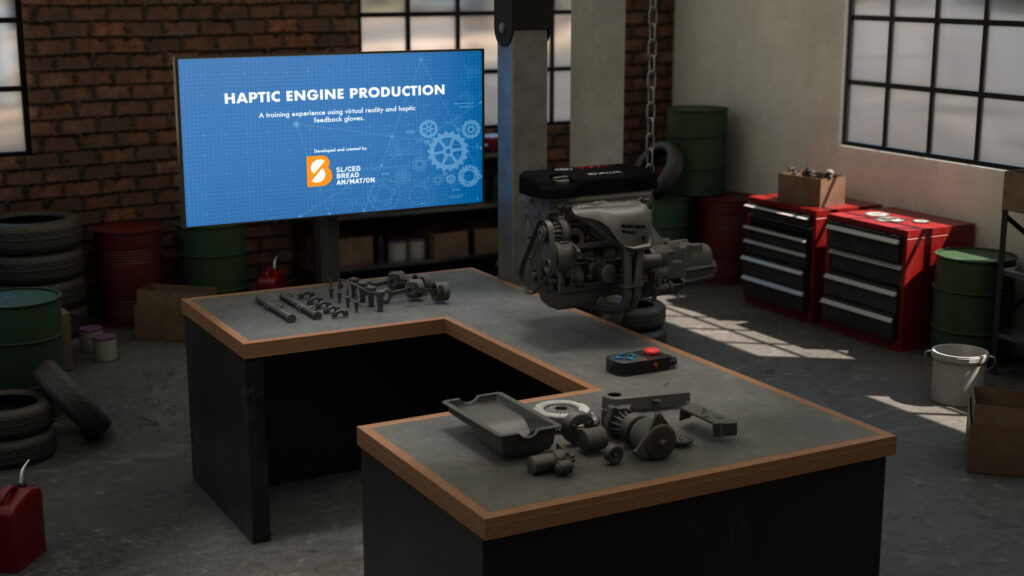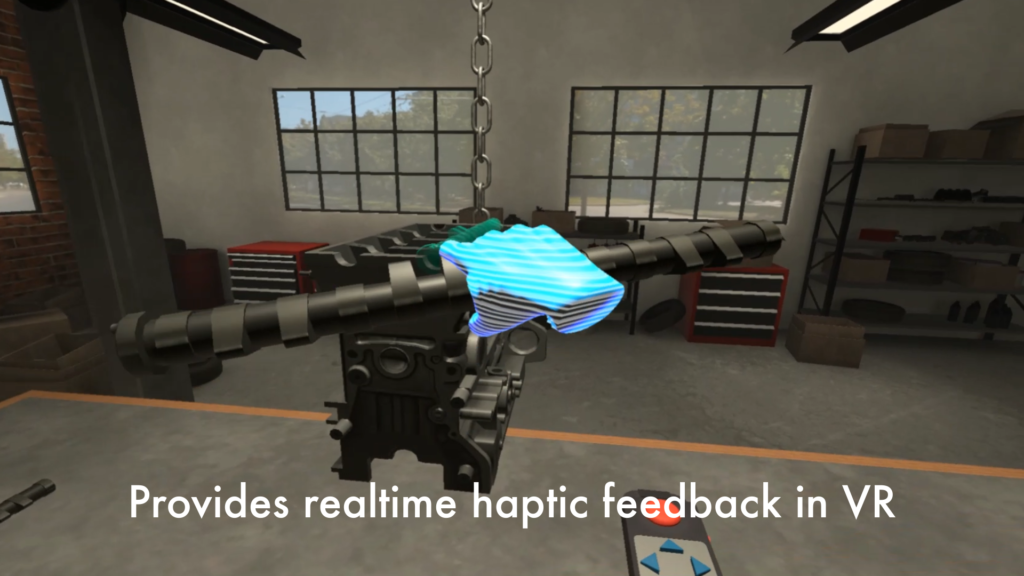With several years of commercial e-learning projects designed and developed for virtual reality devices, Sliced Bread Animation has taken a look to further build on this knowledge-base by adding haptic and force feedback aspects to e-learning experiences.
In relation to the technology world, haptic feedback encapsulates every device that provides a sensation of digital touch. The key aspect of haptic technology is interactivity. Specifically, when it is the user’s intention to interact with any digital content enabled to physically transmit feedback in the form of vibrations back to the user. Content of this manner may also provide sensations that could simulate force mechanically related to the position and movement of the user’s body.
The Haptic Engine Production project is a showcase of the possibilities of designing and developing e-learning virtual reality (VR) products with haptics at the core of the principle requirements. The aim of the project is to direct and teach a user on the various components of an internal combustion engine and what it takes to put it all together to finally build a motor vehicle engine.
Evaluation
Utilising SenseGlove’s haptic glove devices, a user will be tasked to use their hands to pick up and put together an engine in a virtual auto-mechanic’s environment. Initially the user will be asked to synchronise their hands with the virtual hands in the program. This is to make certain that the gloves closely mimic the user’s real world motions and mechanically restrict finger movements in the right positions.
The project breaks up the building process into a number of stages, further breaking down each addition of a component into easy to digest steps. Where the user will attach the components to the cylinder block and head of the engine. Beginning with components such as the Camshaft, Spark Plugs and Bearing Caps. At the end of all the stages, not only will the user have assembled the engine but would have learned about the intricate parts that make an engine function.
The project incorporates gamification ideologies as part of the learning process, allowing users to progress when the correct engine parts were placed into their respective slots. If on the other hand, the parts were placed in the wrong order they then would be reset back to their respective places on the workbench.
Aside from the step by step process displayed as texts on monitor screens in the virtual environment, which further explain what the parts are called and how they function, users are given a guide as to where on the cylinder block to slot the engine parts. When a user picks up a component, the respective slot will be illuminated to bring attention to the user. If the component slot is just beyond reach, the user can rotate the engine block to gain better access to all angles of the engine.
When all the parts of a stage are assembled the user is encouraged with a completion message before being shown what the next stage expects from them. When the engine is fully completed the user will be congratulated on a job well done.
Findings
Utilising the immersive nature of VR as a tool for e-learning allows a user to grasp theoretical concepts much more quickly than the traditional research from instructional notebooks and journals. The greatest advantage of e-learning in this format is that it will increase the instances of connecting with the key concepts of the learning material. Not just by being engaging and interactive, but also allowing the learner to experiment and make mistakes in practice and learn by doing.
Another advantage is the low cost of production, whereby users can work through the virtual scenarios where the environment might involve devices and tools that otherwise would be expensive in the real world.
Although mobile devices and tablets have added touchscreen functionality to the experience of e-learning, these devices still do not compare to the sensory experience incurred by VR paired with haptic capable devices.
Conclusions
The Haptic Engine Production was developed to demonstrate the benefits of virtual haptics e-learning using internal combustion engines as the topic.
To further develop this project from a technical perspective, the project could be developed to allow for multiple VR devices such as the Vive, and the Oculus. Furthermore, to improve the learning experience the project could implement a Learning Management System to track certain aspects such as time taken to complete and the number of components that were incorrectly attached to the engine.
Do you need to develop scenario based e-learning either via Articulate Storyline, Augmented Reality or Virtual Reality? Why not drop us an email at info@sbanimation.com, or give us a call on +44 (0)207 148 0526. We would be happy to help. For further reading see our case study VR Employee Training, by clicking here.










